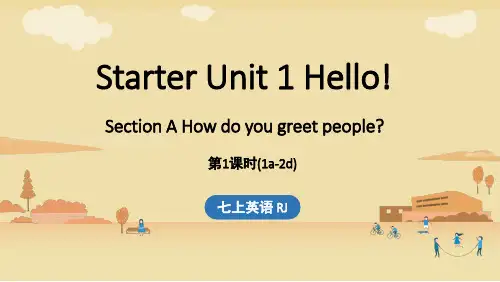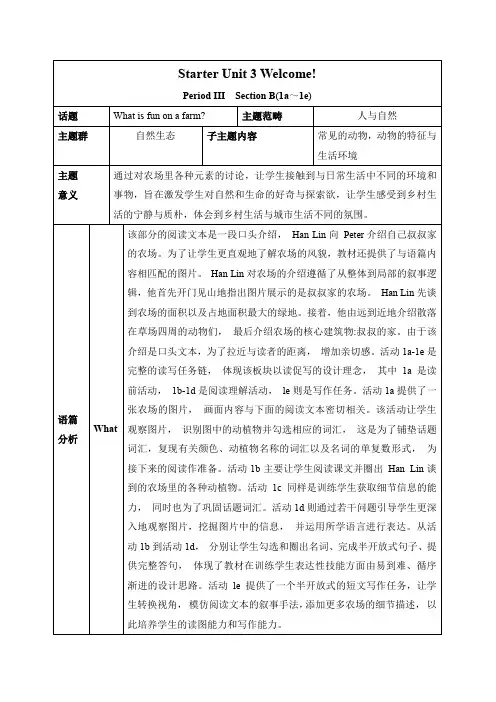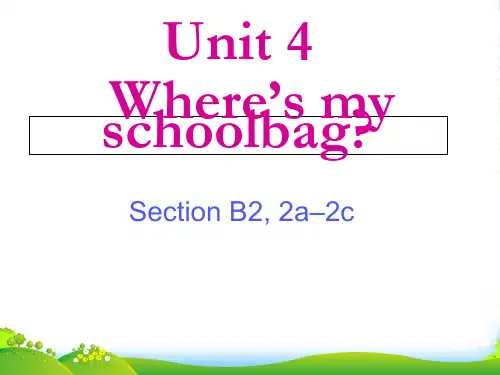新人教版七年级英语上册课件
- 格式:docx
- 大小:22.21 KB
- 文档页数:11



Starter Unit 3 Welcome!Period III Section B(1a~1e)话题What is fun on a farm?主题范畴人与自然主题群自然生态子主题内容常见的动物,动物的特征与生活环境主题意义通过对农场里各种元素的讨论,让学生接触到与日常生活中不同的环境和事物,旨在激发学生对自然和生命的好奇与探索欲,让学生感受到乡村生活的宁静与质朴,体会到乡村生活与城市生活不同的氛围。
语篇分析What该部分的阅读文本是一段口头介绍,Han Lin向Peter介绍自己叔叔家的农场。
为了让学生更直观地了解农场的风貌,教材还提供了与语篇内容相匹配的图片。
Han Lin对农场的介绍遵循了从整体到局部的叙事逻辑,他首先开门见山地指出图片展示的是叔叔家的农场。
Han Lin先谈到农场的面积以及占地面积最大的绿地。
接着,他由远到近地介绍散落在草场四周的动物们,最后介绍农场的核心建筑物:叔叔的家。
由于该介绍是口头文本,为了拉近与读者的距离,增加亲切感。
活动1a-1e是完整的读写任务链,体现该板块以读促写的设计理念,其中1a是读前活动,1b-1d是阅读理解活动,le则是写作任务。
活动1a提供了一张农场的图片,画面内容与下面的阅读文本密切相关。
该活动让学生观察图片,识别图中的动植物并勾选相应的词汇,这是为了铺垫话题词汇,复现有关颜色、动植物名称的词汇以及名词的单复数形式,为接下来的阅读作准备。
活动1b主要让学生阅读课文并圈出Han Lin谈到的农场里的各种动植物。
活动1c同样是训练学生获取细节信息的能力,同时也为了巩固话题词汇。
活动1d则通过若干问题引导学生更深入地观察图片,挖掘图片中的信息,并运用所学语言进行表达。
从活动1b到活动1d,分别让学生勾选和圈出名词、完成半开放式句子、提供完整答句,体现了教材在训练学生表达性技能方面由易到难、循序渐进的设计思路。
活动le提供了一个半开放式的短文写作任务,让学生转换视角,模仿阅读文本的叙事手法,添加更多农场的细节描述,以此培养学生的读图能力和写作能力。








新人教版七年级英语上册课件新人教版七年级英语上册课件课前准备教师:准备游戏时所用的图片(食物、蔬菜、动物)。
学生:准备表演时所需道具(服装、假发)。
教学设计Step One :Present the sentence patterns.1. Play a game “How many words do you know?”(利用小游戏调动学生的积极性,同时通过对冠军的介绍引出本课。
) Teacher: After the study of the first three starters, I think most of the students must have known a lot of words. How many words do you know? Let’s play a game to see who know? Let’s play a game to see who knows the most.(Divide all the students into several groups and show a picture(图片略)to them with the computer. Every group can choose two students to join. They are asked to come to the blackboard and write down the words in 30 seconds.) (Group 2 is the champion group. They can write 11 words.)2. Introduce the champion group to the class.(引课方式贴近生活,学生易于接受)Teacher: Congratulations, now Group 2 is the champion. But I don’t know your names. Would you like to introduce yourselves to us?S1& S2:Yes.S1:Hello.My name is Li Lei. Nice to meet you.Ss: Hello, Li Lei. Nice to meet you ,too.Ss: Hello! What’s your name?S2:I’m Sun Ping. How do you do?Ss: How do you do ?Step Two: Drills.1. Make introductions.(通过句型的操练使学生更加熟练掌握所学的句式。
)Teacher: The new term begins. Everyone will meet many new classmates. Do you want to make friends with them? If your answer is “yes”, please introduce yourself in your group.Example:Sa: Hello! I’m Li Lei. What’s your name?Sb: My name’s Zhang Feng. Nice to meet you.Sa: Nice to meet you, too. And what’s your name, please?Sc: Lin Li. How do you do?Sa:How do you do?2. Listen and number the conversations.Teacher: Today I have good news for you. Three new students will come to our class. They are from other countries. Do you want to know them? Let’s l isten to the recording of 1b in Section A.(Students listen to the tape and give the right answers.)Step Three: Make friends.1. Make new friends.(用谈话的方式完成任务,生动活泼,同时更容易向学生进行美德教育。
)Teacher: Now everyone has some new friends. Do you want others to know th em? Do you want more friends? Let’s introduce our new friends to others, OK?Ss: OK.Example:Sa: This is my new friend. His name is Sun Nan.Sb: Hello, Sun Nan. Nice to meet you.Sc: Nice to meet you, too. Look! This is my new friend. Her name is He Lu.Ss: How do you do?Sd: How do you do?(Students can stand up and introduce their friends to others freely. They can greet each other warmly. Everyone in the class can have more friends. They can also know something else about them.)2. The New comers.(以表演的形式完成,使课堂气氛达到高潮。
)Teacher: Just now I said three new students from other countries would come to our class. Now, look! They are here. Let’s give them a warm welcome.(Three “foreign”students come in and all the students clap warmly.)Teacher: It’s their first time to come to China. Would you like to listen to their introductions?Ss: Yes.(Three students can make introductions and act out the dialogue vividly.)Step Three: Sum up.Some students are asked to sum up this lesson. It is how to make new friends and how to greet them. It is very important in the daily life.Homework“How do you meet new visitors at home?Period Two课前准备教师:准备歌曲磁带(歌词)、情景图片及上课所需表格。
学生:需要向父母了解自已名字的含义。
教学设计Step One: Revise the sentence patterns.1. Sing an English song.(用唱歌的方式既带动了气氛,又复习了所学内容。
)Teacher: Yesterday we’ve known each other already. Do you remember your new friends’names? If you do, let’s sing the song “What’s your name?”.Hello! Hello! What’s your name? My name’s Gina.Hello! Hello! What’s his name? His name’s Peter.H ello! Hello! What’s her name? Her name’s Anna.2. Listen to the conversations and finish the exercises.Teacher: Yesterday I made a new friend. Her name is Jenny. She is very lovely. She introduces many friends of hers to me. Do you want to know about th em? Let’s listen to the tape and find out some useful information.(Students listen to the tape and give the right answers.)3. Act out the dialogues.(在特定的情景下表演对话更符合实际,更贴近生活。
)Teacher: Now you’ve known something about introductions and greetings. But if you are in other places, how do you introduce yourself and greet others? Look at the four pictures and imagine you are in such a situation, how do you get to know new friends?(Students can choose any picture they like and act out the dialogues.)Example:(At a party)Sa: Hello! I’m Lucy Green. What’s your name?Sb: My name is Kate Brown, Jim’s classmate. Nice to meet you.Sa: Nice to meet you, too. I’m Jim’s sister. Welcome to Jim’s birthday party. Make yourself at home.Sb: Thanks, I will.Step Two: Choose English names.1. Play a name game.(有效引出“英文名字”这一主题。